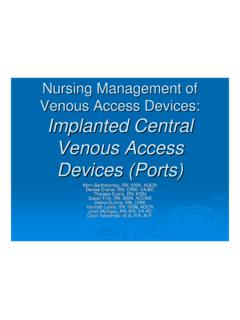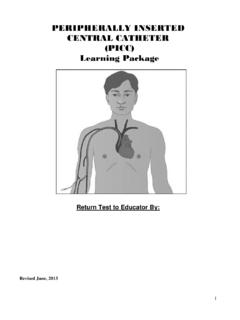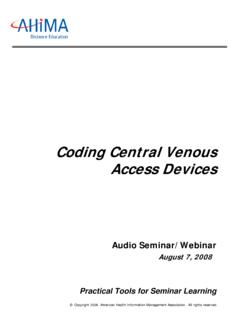Transcription of 138 Central Venous Cannulation - FRCA
1 Sign up to receive ATOTW weekly email ATOTW 138 Central Venous Cannulation 15/6/09 Page 1 of 12 Central Venous Cannulation ANAESTHESIA TUTORIAL OF THE WEEK 138 15TH JUNE 2009 Dr. Will Key, Specialist Registrar - Exeter Hospital, UK Dr. Mike Duffy, Consultant - Derriford Hospital, UK Correspondence to QUESTIONS Before continuing, try to answer the following questions. The answers can be found at the end of the article, together with an explanation. 1. With regard to subclavian vein Cannulation the following statements are true a) The subclavian vein is easily visualised with ultrasonography.
2 B) Cannulation of the subclavian vein is associated with a lower risk of catheter related infections when compared with the femoral route. c) If attempts fail on one side, an attempt at Cannulation of the contralateral subclavian vein should be attempted. d) It is the safest approach in patients with abnormal coagulation. e) Can cause Venous stenosis 2. Regarding mechanical complications. a) If a Central Venous catheter is inserted under ultrasound guidance, a chest radiograph is not required. b) There is an increased risk of chylothorax (lymph) with left sided approach to subclavian and internal jugular veins.
3 C) Chylothorax is an easily treated complication. d) Ultrasound can reduce time to placement for the internal jugular approach as well as reducing mechanical and infectious complications. e) Risk of mechanical complications is higher with the femoral route. 3. The following are proven to reduce infectious complications. a) Antibiotic ointment. b) Scrupulous aseptic technique at the time of insertion . c) Scheduled, routine exchange the of catheter over a guidewire d) Prompt removal of catheter when no longer required e) Avoid femoral Venous catheterization INTRODUCTION Central Venous Cannulation is a relatively common procedure in many branches of medicine particularly in anaesthesia and intensive care medicine.
4 An estimated 200 000 Central Venous access procedures are carried out each year in the United Kingdoms National Health Service and over 5 million in the United States. Historically Central Venous access was gained by a surgical cut-down procedure, but Central Venous catheters (CVCs) are now predominantly inserted percutaneously using a technique first described by Seldinger in 1953. There are many different types of catheter and a number of different sites suitable for Central Venous access with selection depending on numerous factors including reason for and duration of access, anatomy of the patient, local resources and operator skill and experience.
5 Sign up to receive ATOTW weekly email ATOTW 138 Central Venous Cannulation 15/6/09 Page 2 of 12 INDICATIONS The main indications for CVC insertion are listed below. Measurement of Central Venous pressure Infusion of irritant drugs and total parenteral nutrition Difficult peripheral access insertion of pacing wires or pulmonary artery catheters Haemofiltration / haemodialysis Monitoring of mixed Venous or jugular bulb oxygen saturations Replacement of circulating volume Long term intravenous treatment (chemotherapy, antibiotics)
6 CATHETER SELECTION There are a large range of catheters available and selection should be based on site, reason for insertion and length of use. In anaesthesia and intensive care medicine the main considerations are catheter length and number of lumens. Three to five lumens are ideal for critically ill patients allowing multiple different infusions but lumens are usually narrow with a high resistance to flow so less effective for rapid infusion. Larger, shorter catheters such as an Fr introducer sheath are better suited to this purpose also allowing the introduction of longer devices such as a pulmonary artery catheter.
7 Types of catheter Single / multi-lumen Dialysis catheters Peripherally inserted Central catheters (PICC) Tunnelled Implanted ports (for long term use) Lumen size Large greater flows resuscitation, haemofiltration but increased risks 1. larger dead space and 2. significant haemorrhage / air embolus during insertion or inadvertent disconnection 3. thrombosis and subsequent stenosis Narrow allows more lumens per catheter and small dead space therefore better for potent vasoactive agents. Impregnated Catheters There are a number of catheters impregnated with antibiotics/antimicrobials such as chlorhexidine and silver sulfadiazine in an attempt to reduce catheter related infections and can be considered in all patients.
8 However, there is no good evidence of reduced morbidity or mortality and there are cost implications as well as the potential for drug resistance developing. PRINCIPLES OF insertion The basic preparation and equipment required for CVC insertion is the same regardless of site or technique chosen. A suitable clinical area should be chosen where full aseptic technique can be observed. A trained assistant is required and the patient must be monitored with continuous ECG, oxygen saturations and blood pressure measurement.
9 Equipment required is listed below. There is evidence that the use of a dedicated lines trolley increases compliance with best practice. Confirm CVC is needed and select the most appropriate route. Explain the procedure to the patient. Strict Sign up to receive ATOTW weekly email ATOTW 138 Central Venous Cannulation 15/6/09 Page 3 of 12 asepsis at the time of insertion is a major factor in reducing line related infections and good positioning and identification of anatomical landmarks will minimise the risk of failure and complications.
10 In conscious patients local anaesthetic should be used. Equipment required for Central Venous Cannulation Patient on a tilting bed, trolley or operating table Hat, mask and sterile gown and gloves Large sterile drapes and gauze swabs Chlorhexidine in alcohol solution Local anaesthetic with needle and syringe Saline flush Appropriate Central Venous catheter set Three-way taps Scalpel blade Sutures Sterile dressing Ultrasound machine (if available) General technique The most common method of insertion is the catheter over guidewire (Seldinger)

















